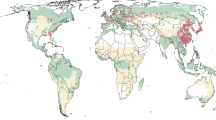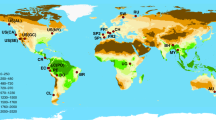Abstract
Increasingly governments and the private sector are using planted forests to offset carbon emissions. Few studies, however, examine how tree diversity — defined here as species richness and/or stand composition — affects carbon storage in these plantings. Using aboveground tree biomass as a proxy for carbon storage, we used meta-analysis to compare carbon storage in tree mixtures with monoculture plantings. Tree mixes stored at least as much carbon as monocultures consisting of the mixture's most productive species and at times outperformed monoculture plantings. In mixed-species stands, individual species, and in particular nitrogen-fixing trees, increased stand biomass. Further motivations for incorporating tree richness into planted forests include the contribution of diversity to total forest carbon-pool development, carbon-pool stability and the provision of extra ecosystem services. Our findings suggest a two-pronged strategy for designing carbon plantings including: (1) increased tree species richness; and (2) the addition of species that contribute to carbon storage and other target functions.
This is a preview of subscription content, access via your institution
Access options
Subscribe to this journal
Receive 12 print issues and online access
$209.00 per year
only $17.42 per issue
Buy this article
- Purchase on Springer Link
- Instant access to full article PDF
Prices may be subject to local taxes which are calculated during checkout




Similar content being viewed by others
References
Hunt, C. Economy and ecology of emerging markets and credits for bio-sequestered carbon on private land in tropical Australia. Ecol. Econ. 66, 309–318 (2008).
Chazdon, R. L. Beyond deforestation: Restoring forests and ecosystem services on degraded lands. Science 320, 1458–1460 (2008).
Diaz, D., Hamilton, K. & Johnson, E. State of the Forest Carbon Markets 2011: From Canopy to Currency (Forest Trends' Ecosystem Markeplace, 2011); http://go.nature.com/gWqaM3
Böttcher, H. & Lindner, M. in Ecosystem Goods and Services from Plantation Forests (eds Bauhus, J., van der Meer, P. J. & Kanninen, M.) 43–76 (Earthscan, 2010).
Cardinale, B. et al. Biodiversity loss and its impact on humanity. Nature 486, 59–67 (2012).
Cardinale, B. J. et al. The functional role of producer diversity in ecosystems. Am. J. Bot. 98, 572–592 (2011).
Díaz, S., Hector, A. & Wardle, D. A. Biodiversity in forest carbon sequestration initiatives: Not just a side benefit. Curr. Opin. Environ. Sustain. 1, 55–60 (2009).
Díaz, S., Wardle, D. A. & Hector, A. in Biodiversity, Ecosystem Functioning, and Human Wellbeing: An Ecological and Economic Perspective (eds Naeem, S. et al.) 149–166 (Oxford Univ. Press, 2009).
McKinley, D. C. et al. A synthesis of current knowledge on forests and carbon storage in the United States. Ecol. Appl. 21, 1902–1924 (2011).
Crossman, N. D., Bryan, B. A. & Summers, D. M. Carbon payments and low-cost conservation. Conserv. Biol. 25, 835–845 (2011).
Harper, R. J. et al. The potential of greenhouse sinks to underwrite improved land management. Ecol. Eng. 29, 329–341 (2007).
Kossoy, A. & Guigon, P. State and Trends of the Carbon Market 2012 (Carbon Finance, World Bank, 2012).
Potvin, C. et al. An ecosystem approach to biodiversity effects: Carbon pools in a tropical tree plantation. Forest Ecol. Manage. 261, 1614–1624 (2011).
Scherer-Lorenzen, M., Schulze, E-D., Don, A., Schumacher, J. & Weller, E. Exploring the functional significance of forest diversity: A new long-term experiment with temperate tree species (BIOTREE). Perspect. Plant Ecol. 9, 53–70 (2007).
Hooper, D. et al. Effects of biodiversity on ecosystem functioning: A concensus of current knowledge. Ecol. Monogr. 75, 3–35 (2005).
Gifford, R. M. Carbon Contents of Above-ground Tissues of Forest and Woodland Trees Technical Report No. 22 (Australian Greenhouse Office, 2000).
Fahey, T. et al. Forest carbon storage: Ecology, management, and policy. Front. Ecol. Environ. 8, 245–252 (2010).
Piotto, D. A meta-analysis comparing tree growth in monocultures and mixed plantations. Forest Ecol. Manage. 255, 781–786 (2008).
Vilá, M., Vayreda, J., Gracia, C. & Ibáñez, J. J. Does tree diversity increase wood production in pine forests? Oecologia 135, 299–303 (2003).
Austin, M. T. Short-rotation biomass trial of mixed and pure stands of nitrogen-fixing trees and Eucalyptus grandis. Austral. For. 60, 161–168 (1997).
Parrotta, J. Productivity, nutrient cycling, and succession in single- and mixed-species plantations of Casuarina equisetifolia, Eucalyptus robusta, and Leucaena leucocephala in Puerto Rico. Forest Ecol. Manage. 124, 45–77 (1999).
Gurevitch, J. & Hedges, L. V. in Design and Analysis of Ecological Experiments (eds Scheiner, S. M. & Gurevitch, J.) 349–369 (Oxford Univ. Press, 2001).
Gurevitch, J. & Hedges, L. V. Statistical issues in ecological meta-analyses. Ecology 80, 1142–1149 (1999).
MetaWin: Statistical Software for Meta-Analysis v.2.0 (Sinaurer Associates, 1999).
Vilá, M. et al. Species richness and wood production: A positive association in Mediterranean forests. Ecol. Lett. 10, 241–250 (2007).
Forrester, D. I., Bauhus, J. & Cowie, A. L. Carbon allocation in a mixed-species plantation of Eucaluptus globulus and Acacia mearnsii. Forest Ecol. Manage. 233, 275–284 (2006).
Erskine, P. D., Lamb, D. & Bristow, M. Tree species diversity and ecosystem function: Can tropical multi-species plantations generate greater productivity? Forest Ecol. Manage. 233, 205–210 (2006).
Binkley, D., Senock, R., Bird, S. & Cole, T. G. Twenty years of stand development in pure and mixed stands of Eucalyptus saligna and nitrogen-fixing Facaltaria moluccana. Forest Ecol. Manage. 182, 93–102 (2003).
Piotto, D., Craven, D., Montagnini, F. & Alice, F. Silvicultural and economic aspects of pure and mixed native tree species plantations on degraded pasturelands in humid Costa Rica. New Forest. 39, 369–385 (2010).
Pretzsch, H. & Schütz, G. Transgressive overyielding in mixed compared with pure stands of Norway spruce and European beech in Central Europe: Evidence on stand level and explaination on individual tree level. Eur. J. For. Res. 128, 183–204 (2009).
Forrester, D. I., Cowie, A. L., Bauhus, J., Wood, J. T. & Forrester, R. I. Effects of changing the supply of nitrogen and phosphorus on growth and interactions between Eucalyptus globulus and Acacia mearnsii in a pot trial. Plant Soil 280, 267–277 (2006).
Kaye, J. P., Resh, S. C., Kaye, M. W. & Chimner, R. A. Nutrient and carbon dynamics in a replacement series of Eucalyptus and Albizia trees. Ecology 81, 3267–3273 (2000).
Marquard, E. et al. Plant species richness and functional group composition drive overyielding in a six-year grassland experiment. Ecology 90, 3290–3302 (2009).
Perring, M. P. et al. The Ridgefield Multiple Ecosystem Services Experiment: Can restoration of former agricultural land achieve multiple outcomes? Agr. Ecosyst. Environ. 163, 14–27 (2012).
Powers, J. S., Corre, M. D., Twine, T. E. & Veldkamp, E. Geographic bias of field observations of soil carbon stocks with tropical land-use changes precludes spatial extrapolation. Proc. Natl Acad. Sci. USA 108, 6318–6322 (2011).
Vesterdal, L. et al. in Environmental Efects of Aforestation in North-Western Europe (eds Heil, G. W. et al.) 19–51 (Springer, 2007).
Isbell, F. et al. High plant diversity is needed to maintain ecosystem services. Nature 477, 199–202 (2011).
Zavaleta, E. S., Pasari, J. R., Hulvey, K. B. & Tilman, G. D. Sustaining multiple ecosystem functions in grassland communities requires higher biodiversity. Proc. Natl Acad. Sci. USA 107, 1443–1446 (2010).
Diaz, D. Moving beyond the buffer pool. Ecosystem Marketplace (November 30 2010); http://go.nature.com/S4DfCn
Yachi, S. & Loreau, M. Biodiversity and ecosystem productivity in a fluctuating environment: The insurance hypothesis. Proc. Natl Acad. Sci. USA 96, 1463–1468 (1999).
Jactel, H. & Brockerhoff, E. G. Tree diversity reduces herbivory by forest insects. Ecol. Lett. 10, 835–848 (2007).
Woods, A., Coates, K. D. & Hamann, A. Is an unprecedented Dothistroma needle blight epidemic related to climate change? Bioscience 55, 761–769 (2005).
Bekessy, S. A. & Wintle, B. A. Using carbon investment to grow the biodiversity bank. Conserv. Policy 22, 510–513 (2008).
Ecosystems and Human Well-being: Biodiversity Synthesis (Milleneium Ecosystem Assessment, World Resources Institute, 2005).
Nadrowski, K., Wirth, C. & Scherer-Lorenzen, M. Is forest diversity driving ecosystem function and service? Curr. Opin. Environ. Sustain. 2, 75–79 (2010).
Hartley, M. J. Rationale and methods for conserving biodiversity in plantation forests. Forest Ecol. Manage. 155, 81–95 (2002).
Cairns, M. A., Brown, S., Helmer, E. H. & Baumgardner, G. A. Root biomass allocation in the world's upland forests. Oecologia 111, 1–11 (1997).
Mokany, K., Raison, R. J. & Prokushkin, A. S. Critical analysis of root : shoot ratios in terrestrial biomes. Glob. Change Biol. 12, 84–96 (2006).
Compliance Offset Protocol U.S. Forest Projects (Air Resources Board, CEPA, 2011); http://go.nature.com/HVqaof.
The Carbon Farming Initiative Handbook Version 1 (Department of Climate Change and Energy Efficiency, Australian Government, 2012); http://go.nature.com/YFuaEQ
Methodology Determinations (Department of Industry, Innovation, Climate Change, Science, Research and Tertiary Education, Australian Government, 2013); http://go.nature.com/54tcXg
Acknowledgements
We acknowledge funding support from the Australian Research Council, through an Australian Laureate Fellowship to R.J.H., the ARC Centre of Excellence for Environmental Decisions and the National Environmental Research Program Environmental Decisions Research Hub.
Author information
Ethics declarations
Competing interests
The authors declare no competing financial interests.
Supplementary information
Supplementary information
Background information for studies included in meta-analyses. (PDF 1224 kb)
Rights and permissions
About this article
Cite this article
Hulvey, K., Hobbs, R., Standish, R. et al. Benefits of tree mixes in carbon plantings. Nature Clim Change 3, 869–874 (2013). https://doi.org/10.1038/nclimate1862
Received:
Accepted:
Published:
Issue Date:
DOI: https://doi.org/10.1038/nclimate1862
This article is cited by
-
Wilder rangelands as a natural climate opportunity: Linking climate action to biodiversity conservation and social transformation
Ambio (2024)
-
Above- and belowground composition and diversity of subtropical plantations and their relationships with soil nutrient stocks
Plant and Soil (2024)
-
Enhancing Tree Performance Through Species Mixing: Review of a Quarter-Century of TreeDivNet Experiments Reveals Research Gaps and Practical Insights
Current Forestry Reports (2024)
-
Economic potential and management of tropical mixed-species plantations in Central America
New Forests (2023)
-
Urban food forestry transforms fine-scale soil function for rapid and uniform carbon sequestration
Urban Ecosystems (2023)



